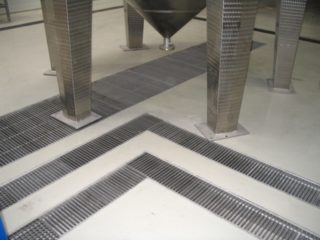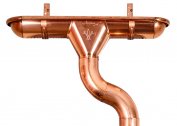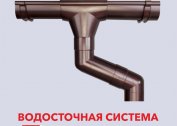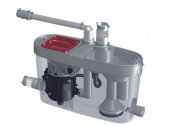Stainless steel drainage trays are an important element in the overall design of the sewage system. They are used to collect used water and its subsequent discharge into the sewage pipeline.
Product Scope
Stainless steel tray products are used both indoors and in open areas. In the first case, they are used for industrial needs:
- at public catering enterprises;
- at points of sale;
- in the manufacture of medicines, perfumes and cosmetics;
- in medical institutions and laboratories;
- in pools, bath-laundries and saunas;
- in the oil refining industry.
Open use of trays is possible for water drainage from garden paths, balcony and terrace structures, glazed facades, flights of stairs. The devices are used to create winter gardens and green roofs.
Specifications
Drainage structures look like gutters, the bottom of which is made so that its halves converge in the center at an angle. Due to this, the trays are less clogged. The housing is usually rounded in shape, which helps to reduce the sedimentation of contaminants and facilitates easy cleaning.
Dimensional indicators of devices:
- The initial depth varies from 60 to 90 mm, the final - from 100 to 300 mm.
- Width from 100 to 400 mm.
- Standard section lengths are from 1000 to 9000 mm.
Manufacturers offer designs with two options for sectioning along the length of the section: simple and variable. The latter option is suitable for those cases when there is no way to derive the required slope by gender. Creating the right angle at the bottom of the tray allows you to provide the necessary rigidity of the entire structure and effective drainage.
Products are made of stainless steel alloys with a thickness of one and a half to three millimeters.
Parts of the trays are connected by welding or using flanges at the ends of the sections. Assembly of the chute sections is carried out with stainless bolts through the gasket.
To prevent various debris from entering the drain, the products are equipped with steel grates. Water passes through them, and large garbage fractions remain on the surface. There are slotted options when the upper surface with longitudinal holes is already attached to the body.
Mounting Features
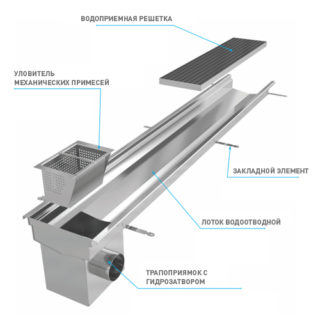 Before installing the tray, you will need to mount all its elements, strictly following the assembly diagram in such a way as to ensure the tightness of the flange joints.
Before installing the tray, you will need to mount all its elements, strictly following the assembly diagram in such a way as to ensure the tightness of the flange joints.
Installing the steel gutter:
- The tray becomes in its intended place and is aligned horizontally by adjusting the legs in height. The top of the gutter should be a centimeter below the floor.
- The metal channel is rigidly fixed to prevent its displacement during the pouring of concrete. To this end, the legs are bolted to the floor or welded to the fittings.
- The transverse partitions are inserted into the places of installation of the gratings in order to avoid compression of the tray across the width during concreting.
- All removable gutter parts are removed: grates, waste bins, siphons.
- Concrete mortar is poured to the level of fasteners.
- When the concrete sets slightly, the structure is checked for distortion.
- The concrete mixture is poured to the edges of the structure.
In hard to reach places, the solution is applied with a spatula.
Steel trays are connected to the ladders connecting them to the sewage system. These parts can be used independently if they are placed in places of point catchment.
The drain parts are small tanks. They are equipped with horizontal and vertical outlets for connection to a drain pipe. Due to the difference in connection methods, it is easy to install them where the sewer network is already equipped.
Advantages and disadvantages
Stainless steel products, beams, ladders, trays, have the main advantage: they are not afraid of corrosion and are resistant to aggressive external influences, both chemical and temperature.
Other advantages of tray devices include:
- increased throughput;
- strength and durability;
- variety of configurations;
- aesthetically attractive look;
- compatibility with any floor coverings;
- simplicity of leaving and control of functioning;
- self-cleaning ability;
- environmental safety.
The disadvantages of such designs include their rather high cost. Extremely high loads, which are on busy highways, they will not stand.
Steel tray products comply with all sanitary standards. They can not do without in enterprises where these requirements are especially stringent.
